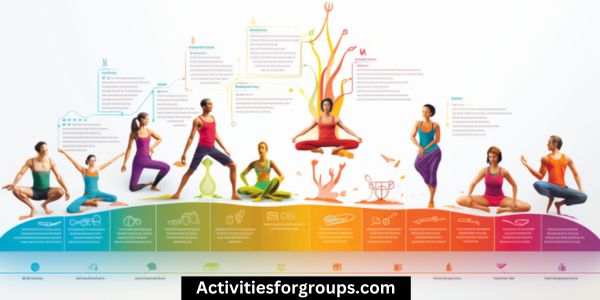Are you looking for a way to bring yoga to your community?
You can start by organizing group yoga sessions. It’s easier than you think; all you need to do is assemble a group, schedule sessions, establish goals, set rules, and maintain structure.

Get ready to bring yoga to your city!
Assembling a Group
Gathering a group of at least five people is the first step to organizing a successful yoga session. Finding participants doesn’t have to be difficult and there are several ways to go about it. You can start by asking your family and friends if they’d like to join.
You can also post flyers in your local community or advertise in online forums to attract more people. You can also reach out to local yoga studios and inquire if they’ve any members who are interested in participating.
Once you have enough participants, it’s time to create teams. You can divide the group into teams of five or more people, depending on the size of the group.
This will help ensure that everyone has the same amount of support and attention during the session. Assign a team leader for each group and provide them with resources and guidance.
Communicate with the group regularly and keep everyone up-to-date on any changes to the schedule or session plan. This will help ensure everyone is on the same page and that everyone is aware of their responsibilities.
Additionally, make sure to give everyone ample time to ask questions and provide feedback on the session plan. This will ensure the group is organized and prepared for the session.
Scheduling Sessions
Once you’ve assembled the group and created teams, it’s time to schedule the yoga sessions. To do this, you’ll need to find a space that’s suitable for the group size and accessible for everyone.
Depending on the size of the group and the availability of space, this may involve finding a larger space such as a gym, or multiple smaller spaces like studios.
Then, you’ll need to allocate time for the yoga sessions. Consider the time of day that works best for everyone, or if it’s feasible to hold sessions on multiple days. Be sure to factor in any other commitments the group may have when allocating time.
Establishing Goals
Now that you have a space and schedule in place, it’s time to establish goals for your group yoga sessions. The process of developing plans that encourage participation and bring the group together is essential for successful group yoga sessions.
Begin by making a list of the intended goals. Consider what you want your yoga group to accomplish in the short-term and long-term. This could include such objectives as increased flexibility, improved strength, and increased mindfulness.
| Short-Term Goals | Long-Term Goals |
|---|---|
| Increased Flexibility | Improved Strength |
| Stress-Relief | Increased Mindfulness |
In order to achieve these goals, consider what methods you can use to encourage participation. Create a plan to motivate members to attend regularly and to engage with one another. This could include an incentive program or a reward system.
Think about the best way to deliver the yoga classes. Decide if you will use a structured plan or if you will allow some flexibility. Also, consider if you need to provide supplies and materials to your group.
Finally, be sure to record your progress. Keeping track of your group’s achievements will help you assess the success of your goals and plan for the future.
When you have a clear set of goals and a plan for achieving them, your group yoga sessions will be successful and enjoyable for everyone.
Setting Rules

Before you begin your group yoga sessions, it’s important to set some ground rules to ensure everyone’s safety and comfort. Establishing expectations upfront can help manage expectations and ensure everyone is on the same page.
It’s important to let participants know what you expect from them, as well as what they can expect from you. Make sure all participants are aware of the rules and that any rules are enforced consistently.
Include rules for class etiquette, such as arriving on time, refraining from distracting conversations, and refraining from eating or drinking in class.
You may also want to consider setting guidelines for physical contact, such as no touching or adjusting of other students. It’s also important to make sure that participants understand the level of intensity for the class.
Be sure to make any rules clear and concise, and ensure participants understand why each rule is in place. Consider having a discussion at the beginning of each session to review the rules, and make sure everyone is comfortable with them.
Maintaining Structure

You need to maintain structure in your group yoga sessions in order to ensure a successful experience for all participants. This means that you need to create a plan that will keep everyone engaged and motivated. You should also make sure that everyone has enough time to complete the session and that there is an appropriate amount of rest in between activities.
Staying motivated and on track is key to your group’s success. Incorporating games, music, and other fun activities can help keep everyone engaged and provide a sense of structure. Additionally, providing clear instructions and expectations for each activity can help keep the energy up.
Time management is also an important factor in maintaining structure. Make sure everyone has enough time to complete the activities and get the most out of the session. It’s also important to set a realistic timeline for each activity and to keep track of the time.
| Activity | Time | Motivation |
|---|---|---|
| Stretches | 10 min | Fun music |
| Balance Exercises | 10 min | Games |
| Meditation | 10 min | Guided imagery |
| Breathing Exercises | 10 min | Relaxing music |
| Relaxation | 10 min | Positive affirmations |
Frequently Asked Questions [FAQs]
What Type of Space Is Necessary for a Group Yoga Session?
You’ll need a large, open space to accommodate yoga mats for the group. Think about the group dynamics and how much space each person will need to move freely.
What Type of Yoga Poses Are Suitable for a Group Setting?
When it comes to group yoga, poses that promote physical and mental benefits as well as group dynamics are best. Consider poses that focus on relaxation, stretching, and breathing.
How Do I Ensure That All Participants Are Comfortable With the Group Yoga Session?
Ensure all participants feel comfortable by introducing group dynamics and relaxation techniques. Ask if anyone has questions or concerns before beginning and during the session.
What Type of Equipment Is Necessary for a Group Yoga Session?
You’ll need yoga mats and other props to ensure comfort during the group yoga session. Be sure to also incorporate breathing techniques to help the participants relax.
How Do I Encourage Participation and Engagement in a Group Yoga Session?
Create an engaging environment where participants can feel supported. Structure the session with fun activities that help to keep everyone engaged.
Conclusion
Congratulations! You’ve made it to the end of the journey to plan a successful group yoga session.
By assembling a group, scheduling sessions, establishing goals, setting rules, and maintaining structure, you have all the tools you need to ensure a successful and meaningful experience for everyone.
With your dedication and hard work, you can look forward to a fulfilling experience for all!




Leave a Reply